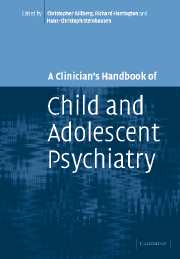Book contents
- Frontmatter
- Contents
- Preface
- List of contributors
- 1 Brain disorders
- 2 Substance use disorders
- 3 Schizophrenia and schizophrenia-like disorders
- 4 Affective disorders
- 5 Anxiety disorders
- 6 Obsessive-compulsive disorders
- 7 Adjustment disorders
- 8 Post-traumatic stress disorder
- 9 Functional somatic symptoms and somatoform disorders in children
- 10 Eating disorders: anorexia nervosa and bulimia nervosa
- 11 Sleep disorders
- 12 Personality disorders
- 13 Mental retardation/learning disability
- 14 Specific developmental disorders of speech and language
- 15 Reading and other learning disorders
- 16 Autism spectrum disorders
- 17 Hyperkinetic disorders
- 18 Conduct disorders
- 19 Elective mutism
- 20 Attachment and disorders of attachment
- 21 Tic disorders
- 22 Elimination disorders: enuresis and encopresis
- 23 Physical and sexual abuse
- 24 Gender identity disorders
- Index
- References
23 - Physical and sexual abuse
Published online by Cambridge University Press: 06 August 2009
- Frontmatter
- Contents
- Preface
- List of contributors
- 1 Brain disorders
- 2 Substance use disorders
- 3 Schizophrenia and schizophrenia-like disorders
- 4 Affective disorders
- 5 Anxiety disorders
- 6 Obsessive-compulsive disorders
- 7 Adjustment disorders
- 8 Post-traumatic stress disorder
- 9 Functional somatic symptoms and somatoform disorders in children
- 10 Eating disorders: anorexia nervosa and bulimia nervosa
- 11 Sleep disorders
- 12 Personality disorders
- 13 Mental retardation/learning disability
- 14 Specific developmental disorders of speech and language
- 15 Reading and other learning disorders
- 16 Autism spectrum disorders
- 17 Hyperkinetic disorders
- 18 Conduct disorders
- 19 Elective mutism
- 20 Attachment and disorders of attachment
- 21 Tic disorders
- 22 Elimination disorders: enuresis and encopresis
- 23 Physical and sexual abuse
- 24 Gender identity disorders
- Index
- References
Summary
Introduction
There have been records of the abuse of children in many parts of the world. Historical records exist of unkempt, malnourished, rejected and abused children. However, the issue did not receive widespread attention medically until the publication of Kempe's seminal work, The Battered Child Syndrome in 1962. The term was coined to characterize the clinical manifestations of serious physical abuse in young children. It is now evident that child abuse is a global problem, which occurs in a variety of forms and is deeply rooted in cultural, economic and social practices. Kempe described the sequence of the ways in which societies begin to perceive and socially construct the different forms of abuse. He described the first observation of the severely physically abused child, followed by an awareness of the neglected child, then an awareness that children could be rejected and emotionally abused in their families, and in institutions, or could be induced into illness states by parents who themselves need support through the medical pathway. He also described the process of recognition of the extensive inappropriate sexual activities with children.
This chapter will look at the different phenomena of abusive actions against children, attempt to identify some unifying themes and how they influence the way that professionals act, and to define the role and tasks of child and adolescent psychiatrists.
- Type
- Chapter
- Information
- A Clinician's Handbook of Child and Adolescent Psychiatry , pp. 655 - 694Publisher: Cambridge University PressPrint publication year: 2006
References
- 1
- Cited by



